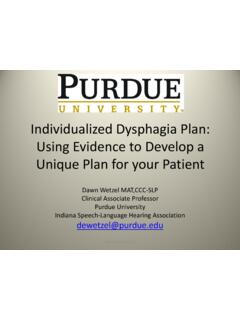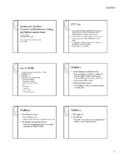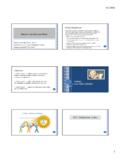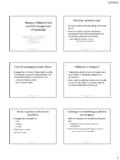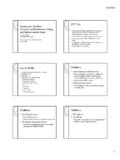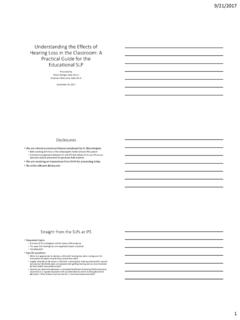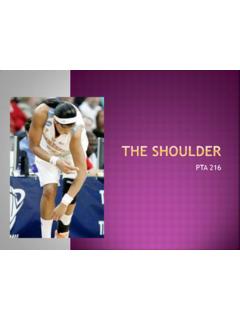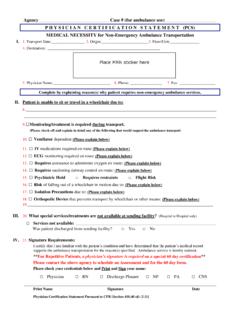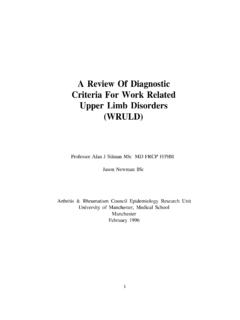Transcription of Evidenced-Based DISCLOSURES Interventions for …
1 Eberle, Memory - ISHA 20151 Evidenced-Based Interventions for Impairments of MemoryRebecca D. Eberle, MA, CCC-SLP, BC-ANCDSI ndiana University Department of D. Eberle, , CCC-SLP, BC-ANCDSHas no financial or other interest to discloseLearning Objectives Identify the general guidelines for the use of external memory strategies. Define and state the training stages in Memory Notebook procedures. Identify types of external memory devices and aids. State the procedures for the treatment strategies for severe memory impairment Define and state types of metacognitive strategy training for memory for the Presentation Overview of Memory Systems BI-ISIG Recommendations for Memory Impairment Determining which Approach to Use: External Compensations or Strategy Training?
2 External Compensations Strategies for Severe Memory Impairment Memory Strategy TrainingComponents of MemoryAttentionEncodingStorageRetrieval( Sohlberg & Mateer, 2001)Neuroanatomy of MemoryBRAIN REGIONMEMORY FUNCTIONF rontal LobesRetrievalSubcortical Region (hippocampus, amygdala, striatum)Declarative memory (facts, events)Cerebellum, basal gangliaProcedural memory for motor learningEberle, Memory - ISHA 20152 Stages of Memory Processing Registration (sensory memory) Short-term memory Immediate memory Working memory Rehearsal Intermediate memory Long-term memory Consolidation Learning(Lezak, 2012)Registration Holds large mounts of data for seconds Modality specific ( , visual, auditory) Influenced by affect, set (perceptual and response predisposition), and attention-focusing processesVisual Registration SampleShort-Term Memory Immediate memory Simple immediate span of attention (modality-specific) Working memory.
3 Temporary storage & processing system used for problem solving that take place over a limited period of time Rehearsal Repetitive processes to enhance the level of encoding and duration of a memory Intermediate memory? 1-2 days but not permanent Organization of Long-term Memory SystemsDeclarative Conscious recall of objects, information and eventsSemanticKnowledge EpisodicAutobiographical experiences or eventsNondeclarativeNonconscious performance of knowledge or skillsPrimingCued recall of a previously learned responseProcedural skill memory Other Types of Memory Prospective Part of executive functions Remembering to remember Source memory Context in which something was learnedBI-ISIG Recommendations for Treatment of Memory DeficitsPractice StandardMemory strategy training is recommended for mild memory impairments from TBI, including the use of internalized strategies ( , visual imagery)
4 And external memory compensations ( , notebooks).Practice GuidelineUse of external compensations with direct application to functional activities is recommended for people with severe memory deficits after TBI or , Memory - ISHA 20153BI-ISIG Recommendations for Treatment of Memory DeficitsPractice Options For people with severe memory impairments after TBI, errorless learning techniques may be effective for learning specific skills or knowledge, with limited transfer to novel tasks or reduction in overall functional memory problems. Group- based Interventions may be considered for remediation of memory deficits after to Rehabilitation MemoryAPPROACHESTECHNIQUESEXTERNALCOMPEN SATIONO rientationnotebook Errorless learning, spaced retrieval, chainingElectronic deviceCell phone, pager, alarmsMemory notebookMEMORYSTRATEGY TRAININGA ssociationTechniquesVisual-verbal association, visual-verbal schematics, visual peg method, Method of LociOrganizational & Elaboration TechniquesFirst letter mnemonics, semantic clustering, PQRST, use of humor, storytellingChoosing the Right StrategyIs Patient Aware of Deficits?
5 Can Patient Use Notebook or Electronic Device with Assistance?What is patient s level of impairment?Use Techniques to Increase AwarenessUse Task Specific Approach: Errorless Learning, Spaced Retrieval, ChainingUse External Strategies only: Provide Cueing and Assistance NoNoYesYesContinue to use External Strategy with Assistance, if NeededMild/ModSevereUse Memory Strategy TrainingUse both, as needed Use both, as neededAndDecision Tree for Treatment Planning In Memory DysfunctionFigure in Choosing a Strategy Severity of impairment Nature of the information to be remembered Functional, personally meaningful tasks Patient should understand, have input into goals and strategies-active Compensations for Memory ImpairmentEberle.
6 Memory - ISHA 20154 Types of External Devices Notebooks Other written planning systems Electronic planners, PDA s Smart cell phones Computerized systems Auditory or visual systems Task-specific aidsWhichType of External Device?1. The particular task the patient wishes to perform2. The patient s goals, abilities, disabilities and preferences3. The physical features (or limitations) of available technology: audio features, digital options, cost, downloadable apps4. The environment in which technology is going to be The familiarity to the patient. General Guidelines for External Memory Strategies Constant and easy access to the external device or notebook.
7 Training of all staff and family members in the use of device. Errorless learning techniques and use of procedural memory for severely impaired patients. Multiple learning & generalization Guidelines for External Memory Strategies, cont d Address any executive dysfunction. Apply external devices to functional tasks in the daily life of the patient. Use cues early in treatment and fade over time Mild impairment: Rapid fading Severe impairment: Gradual fadingMemory Notebook TypesSevere orPTAO rientation NotebookErrorless LearningSpaced RetrievalChainingMild to ModerateMemory NotebookMemory Notebook Comprises the core of external memory compensations, along with electronic devices.
8 Possible sections: Things to do Memory log Daily schedule Homework History and background Handouts ContactsEberle, Memory - ISHA 20155 Stages in Memory Notebook TrainingGoal: To use notebook in naturalistic settingsStrategies: Feedback, cues, repetition, updating AdaptationGoal: To use notebook on functional tasks in clinicStrategies: Feedback, cues, repetition ApplicationGoal: To learn the names, purpose, & use of each sectionStrategies: Errorless learning, spaced retrievalAcquisition(Sohlberg & Mateer, 2001)Acquisition StageLevel of severity determines which strategies are Mild Errorless Learning Spaced Retrieval Question & Answer Rehearsal Knowledge QuestionsAcquisition StageQuestion & Answer Rehearsal Samples In what section of your Memory Notebook do you plan evening activities?
9 In what section of your Memory Notebook do you record future appointments?Knowledge Questions You should review what you have recorded in the book when _____ You should write in the Memory Log when _____Application Stage Memory notebook is integrated into various structured activities, with the clinician. Tasks are chosen for functionality and relevance for each person Cuing is provided for client learning and successAdaptation Stage Applies skills learned to tasks and responsibilities in naturalistic settings outside the clinic. External device is functionally integrated into daily routines to: Document information, activities Support prospective memory Organize tasksSample Tasks Using device to remember to perform a future action: Bring your iPhone to the next therapy session.
10 Tell your family member 1 thing you did at therapy today. Using device to store/retrieve sets of information: Dates of upcoming medical appointments. Names and types of medicine used. Using device to report information from events/activities: Reporting activities from a visit or past weekend. Reporting information from a work , Memory - ISHA 20156 Updating and Cleaning RoutineDevelop a designated time for review, updating and cleaning of the notebook. Sequence of Steps: Remove old log sheets and place in file. Put in the new sheets - logs Double check work Check the calendar to add any upcoming eventsScoring and Documentation Patient was unable to initiate1 Patient needed moderate assistance to record & retrieve information during session2 Patient needed minimum assistance to either record or retrieve information during the session 3 Patient independently recorded & retrieved all relevant activities and information during the session 4 Strategies for Severe ImpairmentStrategies for Severe Memory Impairment.
